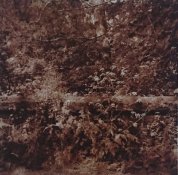ok, so, bear with me here.
I was looking in the cupboard under the sink and I found a bottle with some stuff in it, so I sniffed it.
Hmm well that smells of thymol, so it's probably something with ferric ammonium citrate in it.
ooh there's something floating on the top, definitely ferric ammonium citratey then.
what happens if I shake it?
ahhh, full of precipitatey stuff.
conclusion - old Namias' solution. Very old in fact, probably, um, 18 months or more ...
OK let's filter out the crap and see what's left in the filter paper (I say 'filter paper' like I've got an analytical laboratory here, but what I've actually got is a pack of Melitta coffee filter papers)
Well, what's left is a pale greeny solution and a quarter of a teaspoon (maybe less) of brown/grey powder and flakes of what looks like silver metal. Maybe the brown/grey stuff is silver citrate or somesuch. Or maybe just silver metal too? Or some iron thing beginning with f?
anyhoo, whatever, there's definitely less silver nitrate left in that solution than was in it originally. I wonder how well it works?
(forgets about it for a couple of days)
today: lovely sunny day, sweltering hot again, thin thin cloud, I guess I could make a print. Maybe I'll try another aceto-nitrate print.
Ah, no I won't, I seem to have somehow thrown away my carefully measured 19% solution of Acetic acid. How did that happen? The bathroom stinks tho. Hmm. Maybe I brushed my teeth with it.
I know, I'll try that old Namiasy stuff on the scrap of Tartaric-ed paper I have left over.
4 minutes (or was it 7 minutes? Must try to keep notes! (hahahahah like that'll happen [insert emoji for rolling eyes])) in full sunshine, 1500BST. Not much of an image there, but lets wash it and see ... ooh wow kablooey yes that's worked.
Moral: Making prints without any idea of how to repeat the results because reasons, is fun.

('phone camera renders it a bit too rich and reddish/aubergine according to my eye, so imagine it a bit less rich and reddish/aubergine; and a tad less contrasty)



 ( I really love that camera! ) I'd been waiting to print them until I got these last troubles solved...
( I really love that camera! ) I'd been waiting to print them until I got these last troubles solved...

